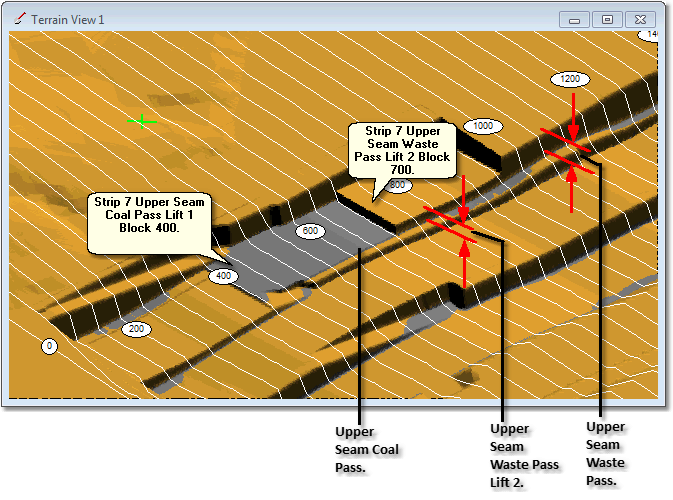|
<< Click to Display Table of Contents >> Automated Excavation Sequencing |
  
|
|
<< Click to Display Table of Contents >> Automated Excavation Sequencing |
  
|
Prerequisites for this Section
Before reading this section you should be familiar with Generic Excavation and Excavation Templates.
To conduct a simulation process an excavation sequence must be set up. In 3d-DigPlus excavation sequences are established on a Pit - Strip - Block - Lift - Pass basis. These terms have the same definition in the software as in general use:
Pit. A pit is an individual self-contained mining pit. Any number of pits can be used as part of the sequence.
Strip. A strip is an increment of the pit excavation process. Typically a pit will consist of a series of incremental approximately parallel strips. However a Strip can be any structure with a polygonal boundary and excavation limits constrained by a Pit Shell Surface.
Block. A block is the element used to subdivide the strip longitudinally.
Pass. A Pass is a horizontal increment of the strip. Typical passes are waste removal passes and coal passes.
Lift. Lifts are used to subdivide passes vertically into increments which can be practically excavated using the available stripping fleet.
These elements are illustrated in the following figure:

Key Elements of a Staged Excavation.
The smallest increment of an automated Excavation is called a Step. A Step extends between two Block Lines horizontally and is limited to a Lift vertically. In the above figure two Steps are illustrated:
The Strip 7 Upper Seam Waste Pass - Lift 2 Block 700 Step.
The Strip 7 Other Seam Coal Pass - Lift 1 Block 400 Step.
Contiguous groups of related Steps are assembled into Subsequences. Subsequences the smallest increment of the schedule. Subsequences are then assembled into a structure called a Supersequence. The Supersequence is equivalent to the proposed schedule, it controls the order in which the excavation progresses.
1.Establishing a Pit and Block lines.
2.Setting up excavation Lifts and Passes and establishing an excavation Raw Sequence (a Raw Sequence is the complete set of Steps for the Strip).
3.Setting up Excavation Subsequences (Subsequence is a contiguous group of Steps).
4.Arranging the Subsequences into a Supersequence (schedule).
Step one is established interactively in 3d-DigPlus terrain window. Steps two and three are established within an Excavation Template. Step four is created in a specialised interface called the Supersequence Editor.
The following video clip shows the excavation of a Supersequence and illustrates the above concepts. The Supersequence excavates a complete Strip of a Pit. The Strip has the following Passes:
•Upper Seam Waste Pass
•Upper Seam Coal Pass
•Mid Seam Waste Pass
•Mid Seam Coal Pass
•Lower Seam Waste Pass
•Lower Seam Coal Pass.
The waste passes are further subdivided into Lifts. Each end of the Strip is excavated from the endwall towards the centre of the Strip, consequently each Lift requires a separate Subsequence for each end.